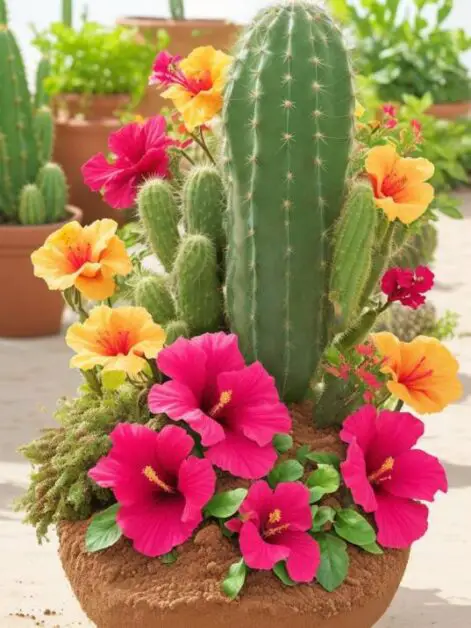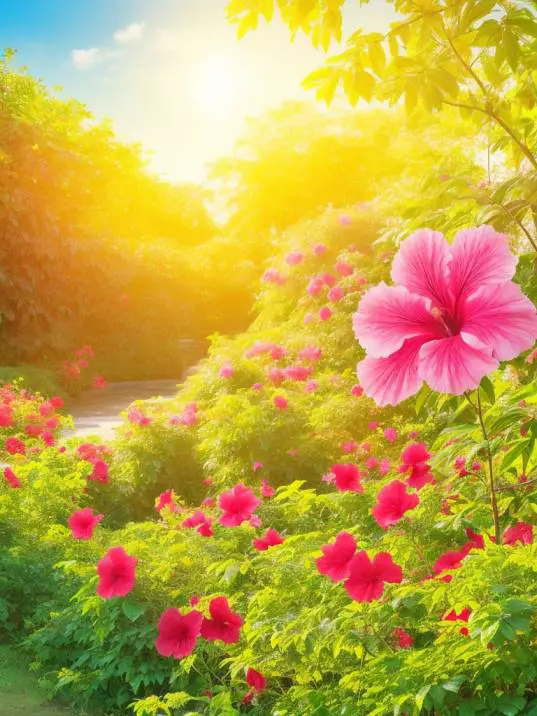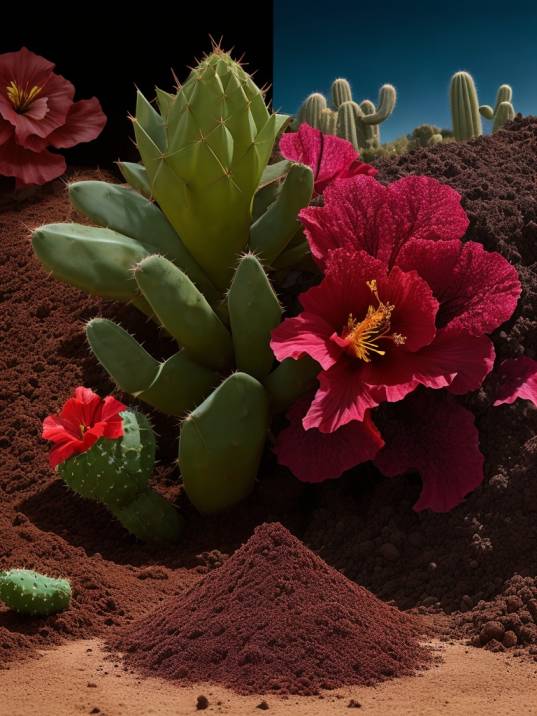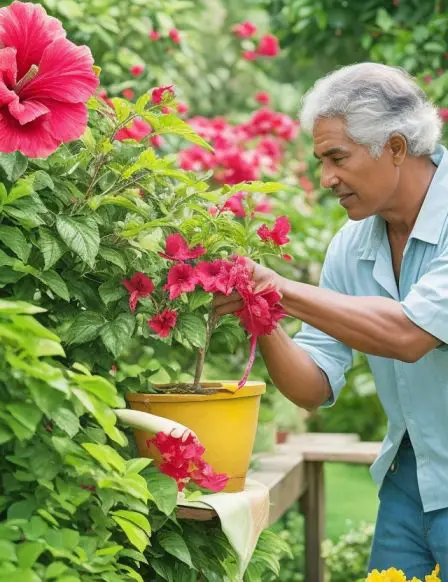Can I use cactus soil for hibiscus? This intriguing question forms the heart of our exploration as we delve into the world of gardening. For those of us who cherish the beauty of hibiscus plants and their vibrant blooms, choosing the right soil is paramount. In this article, we embark on a journey to uncover the best soil options for hibiscus, dissecting the benefits, drawbacks, and expert recommendations. So, if you’ve ever wondered “Can I use cactus soil for hibiscus?” – get ready to unearth the secrets to nurturing flourishing hibiscus plants that truly thrive.
Understanding Cactus Soil and Its Composition

Cactus soil is renowned for its excellent drainage properties, making it a favorite for succulent enthusiasts. Composed of a mix of sand, perlite, and organic matter, cactus soil ensures that water flows through quickly, preventing root rot. While it might seem like a suitable option for hibiscus, there’s more to the story.
Hibiscus Plant Requirements:
Hibiscus plants, with their breathtakingly vibrant blossoms and lush foliage, are a true testament to the beauty of nature. To cultivate these tropical wonders successfully, it’s essential to understand and meet their specific requirements. From soil and sunlight to water and nutrients, let’s delve into the intricacies of hibiscus plant care.
Soil Preferences and Structure
Hibiscus plants thrive in soil that strikes a harmonious balance between drainage and moisture retention. Well-draining soil is crucial to prevent waterlogged roots and root rot, as hibiscus dislikes “wet feet.” However, it’s equally important that the soil retains enough moisture to sustain the plant during hot spells.
pH Levels: The Acidity Connection
The pH level of the soil plays a pivotal role in hibiscus health. These plants flourish in slightly acidic to neutral soil, typically within the pH range of 6.0 to 7.0. This pH environment allows hibiscus to absorb essential nutrients optimally. The right pH fosters vigorous growth, robust foliage, and a profusion of dazzling blooms.
Sunlight Requirements

Hibiscus plants are sun worshippers, reveling in the warmth and energy of sunlight. They thrive when exposed to at least 6 to 8 hours of direct sunlight daily. However, in regions with scorching heat, a touch of afternoon shade can shield the plant from excessive sun exposure. Without adequate sunlight, hibiscus may become leggy and produce fewer flowers.
Watering Practices
Water is life for hibiscus, but moderation is key. While these plants appreciate regular watering, they despise standing in waterlogged soil. A deep watering regimen, allowing the water to reach the root zone, is preferable over frequent shallow watering. This encourages the roots to establish a deep and sturdy network, contributing to overall plant health.
Nutrient Needs
Hibiscus plants have an appetite for nutrients, and providing them with the right nourishment results in lush foliage and breathtaking blooms. Incorporating a balanced fertilizer with a higher phosphorus content (the middle number on fertilizer labels) promotes robust flowering. Slow-release fertilizers are especially beneficial, as they provide a steady supply of nutrients over time.
Pruning and Maintenance
Regular pruning not only helps maintain the shape of your hibiscus plant but also stimulates new growth and flower production. Remove dead or diseased branches and faded flowers to redirect the plant’s energy toward new growth. Pruning also enhances air circulation, reducing the risk of fungal diseases.
Protection from Pests and Diseases
Like any garden inhabitant, hibiscus plants are susceptible to pests and diseases. Keep a watchful eye for common pests like aphids, whiteflies, and spider mites. Regularly inspect your plants for any signs of distress, such as yellowing leaves or unusual spots. Prompt action can prevent these issues from escalating and harming your hibiscus.
Winter Care for Hibiscus
In regions with cold winters, hibiscus can be brought indoors or provided with protective coverings to shield them from frost. If left outdoors, ensure they’re placed in a sheltered spot to minimize exposure to harsh weather conditions.
By understanding these intricacies of hibiscus plant care, you’re better equipped to provide the nurturing environment that these stunning plants deserve. A little attention to detail goes a long way in fostering vibrant hibiscus blooms that captivate the eye and uplift the spirit. Happy gardening!
Comparing Cactus Soil and Hibiscus Soil Needs

While both cactus and hibiscus prefer well-draining soil, the similarities stop there. The pH levels that hibiscus adores may not align with the typically alkaline-leaning cactus soil. Additionally, hibiscus plants benefit from a richer nutrient mix than what cactus soil can provide. Imagine serving a gourmet meal to a food critic – your hibiscus deserves its own tailored soil banquet.
Potential Benefits and Drawbacks of Using Cactus Soil for Hibiscus:
Cons
As gardeners, we’re constantly exploring innovative methods to nurture our plants and witness them flourish. The idea of using cactus soil for hibiscus might pique your curiosity, and while it does come with potential benefits, it’s crucial to weigh them against the drawbacks. Let’s delve into the world of cactus soil for hibiscus and uncover the pros and cons.
Potential Benefits:
- Excellent Drainage: Cactus soil is renowned for its exceptional drainage properties. For hibiscus, which despises waterlogged roots, this could translate to a reduced risk of root rot and other moisture-related issues.
- Aeration: The loose and well-aerated structure of cactus soil can contribute to improved oxygen circulation around hibiscus roots. This can be especially advantageous for root health and overall plant vitality.
- Root Breathability: The gritty texture of cactus soil encourages root growth and development, allowing hibiscus roots to breathe more easily. This can lead to stronger root systems and better nutrient absorption.
Potential Drawbacks:
- pH Mismatch: While cactus soil’s pH tends to be slightly acidic to neutral, hibiscus prefers a more pronounced acidic soil. The pH mismatch might hinder the plant’s ability to absorb essential nutrients, potentially leading to nutrient deficiencies.
- Nutrient Insufficiency: Cactus soil is designed to be lean in nutrients to suit the needs of succulents and cacti. Hibiscus, on the other hand, requires a more nutrient-rich environment to support its robust foliage and prolific flowering.
- Moisture Maintenance: While the quick drainage of cactus soil is advantageous for succulents, it might necessitate more frequent watering for hibiscus. This could become a challenge, especially if you have a busy schedule.
- Limited Organic Matter: Cactus soil often contains minimal organic matter, which hibiscus plants thrive on for nutrient retention and soil structure improvement. A lack of organic material could hinder the long-term health of your hibiscus.
- Blooming Potential: The nutrient deficiency and pH imbalance that cactus soil might introduce could potentially compromise the vibrancy and abundance of hibiscus blooms, one of their most captivating features.
Finding the Balance:
While cactus soil holds certain advantages for hibiscus, it’s essential to find a middle ground that accommodates the specific needs of these tropical plants. Mixing cactus soil with nutrient-rich potting mix, adding organic matter, and adjusting the pH level can help create a more suitable environment for your hibiscus to thrive.
Alternative Soil Mixes for Hibiscus:
Creating the ideal soil mix for your hibiscus plants is akin to preparing a gourmet meal—it requires a careful selection of ingredients and precise measurements to ensure a delightful outcome. While cactus soil may not be the perfect match, let’s explore alternative soil blends that cater to the unique needs of hibiscus and lay the foundation for their flourishing growth and vibrant blooms.
Customized Soil Mix Components:
- Regular Potting Soil: Begin with a base of high-quality potting soil. This provides a stable structure for the mix and contains essential nutrients that support hibiscus growth.
- Perlite: Introduce perlite to the mix to enhance drainage and aeration. Perlite prevents soil compaction and promotes healthy root growth by preventing water from pooling around the roots.
- Sand: Adding sand aids in improving drainage further and ensures that excess water can escape the root zone efficiently. Opt for coarse sand to prevent the soil from becoming overly dense.
- Organic Matter: Incorporate compost or well-rotted manure to infuse the mix with organic nutrients. Organic matter enhances the soil’s water-holding capacity and nutrient retention, while also improving soil structure.
Mixing Ratios and Preparation:
Creating the perfect soil blend involves balancing the components to meet hibiscus’ specific needs. A balanced approach would be to aim for a mix that includes:
- 60% Regular Potting Soil
- 20% Perlite
- 10% Coarse Sand
- 10% Organic Matter (Compost or Well-Rotted Manure)
Mixing Method:
- Gather Ingredients: Collect the required components—the potting soil, perlite, coarse sand, and organic matter.
- Thorough Blending: In a large container, mix the ingredients thoroughly until you achieve a uniform blend. This ensures that each component is evenly distributed throughout the mix.
- Moistening: Before potting your hibiscus, moisten the soil mix slightly. This helps settle the components and ensures that water is distributed evenly during the first watering.
Benefits of the Customized Mix:
- Optimal Drainage: The combination of perlite and sand ensures excellent drainage, preventing waterlogging and root rot.
- pH Balance: The organic matter in the mix contributes to maintaining the slightly acidic to neutral pH range that hibiscus loves.
- Nutrient Richness: The addition of compost or well-rotted manure enriches the soil with organic nutrients, supporting healthy foliage and abundant blooms.
- Root Health: The well-aerated, nutrient-rich, and moisture-retentive mix encourages strong root development, a crucial factor for overall plant health.
Application and Maintenance:
When planting or repotting your hibiscus, fill the chosen container with the custom soil mix. Place the plant in the center, ensuring the root ball is at the appropriate depth. Gently tamp down the soil around the roots to remove any air pockets. Water thoroughly after planting and maintain a consistent watering schedule, allowing the soil to dry slightly between waterings.
Tips for Successful Hibiscus Planting and Care:

Hibiscus, with its captivating blooms and lush foliage, brings a touch of the tropics to any garden or landscape. To ensure these botanical marvels flourish to their fullest potential, it’s essential to provide them with the care they deserve. Here’s a comprehensive guide of tips and tricks for successful hibiscus planting and care:
1. Selecting the Right Location:
- Choose a spot that receives at least 6 to 8 hours of direct sunlight daily. Hibiscus thrives in bright light.
- Ensure the location is sheltered from strong winds, which can damage delicate hibiscus blooms.
2. Soil Preparation:
- Prepare the soil by loosening it to encourage proper root growth.
- If the soil is heavy or clayey, amend it with organic matter to improve drainage and aeration.
3. Planting Technique:
- Dig a hole slightly larger than the hibiscus root ball.
- Place the plant in the hole, making sure it sits at the same depth it was in the nursery container.
- Backfill with soil and gently tamp it down around the roots to remove air pockets.
4. Watering:
- Water deeply after planting to settle the soil around the roots.
- Maintain consistent watering, allowing the top inch of soil to dry out between waterings.
- Avoid overwatering, as hibiscus roots are susceptible to rot in waterlogged soil.
5. Fertilization:
- Use a balanced, slow-release fertilizer formulated for flowering plants.
- Apply the fertilizer during the growing season (spring and summer) to support vigorous growth and blooming.
6. Pruning and Deadheading:
- Regularly prune to encourage bushy growth and stimulate new flowering shoots.
- Remove faded blooms promptly to redirect the plant’s energy into producing new flowers.
7. Pest and Disease Management:
- Keep an eye out for common pests like aphids, mealybugs, and whiteflies. Use insecticidal soap or neem oil if infestations occur.
- Prevent fungal diseases by providing adequate spacing between plants and avoiding overhead watering.
8. Winter Care:
- In colder climates, consider bringing potted hibiscus indoors during the winter.
- For garden-planted hibiscus, cover them with frost cloth or burlap during frosty nights to protect them from cold temperatures.
9. Mulching:
- Apply a layer of organic mulch around the base of the plant to retain moisture, regulate soil temperature, and suppress weeds.
10. Observation and Adaptation:
- Pay attention to how your hibiscus responds to its environment. Adjust watering, fertilizing, and other care practices based on its needs.
11. Repotting:
- If you have hibiscus in containers, consider repotting every 2-3 years to refresh the soil and give the plant room to grow.
12. Support and Training:
- Use stakes or plant supports to provide stability for taller hibiscus varieties.
- Prune and train the plant to encourage a desired shape or form.
13. Enjoy the Journey:
- Gardening is a journey of discovery and learning. Take the time to observe and appreciate the changes in your hibiscus as it grows and blooms.
By following these comprehensive tips for successful hibiscus planting and care, you’re setting the stage for a garden filled with breathtaking beauty and the joy of nurturing nature’s masterpiece. With a little dedication and attention to detail, your hibiscus will reward you with its vibrant and mesmerizing presence. Happy gardening!
Expert Advice and Recommendations:
Gardening is a realm of wisdom passed down through generations, where experienced horticulturists and passionate gardeners share valuable insights for cultivating healthy and vibrant plants. When it comes to hibiscus, tapping into the knowledge of experts can make a remarkable difference in your gardening journey. Let’s delve into their advice and recommendations, which are like treasure troves of guidance.
1. Incorporating Organic Matter:
- Expert: The Royal Horticultural Society (RHS)
- Advice: The RHS emphasizes the importance of incorporating well-rotted compost or organic matter into the soil mix for hibiscus. This enhances soil structure, improves moisture retention, and provides essential nutrients for robust growth and blooming.
- Source: RHS – Improving Your Soil
3. Choosing the Right Fertilizer:
- Expert: University of Florida IFAS Extension
- Recommendation: The University of Florida IFAS Extension suggests using a slow-release, balanced fertilizer with a higher phosphorus content to promote hibiscus flowering. They advise applying the fertilizer according to package instructions for best results.
- Source: University of Florida IFAS – Hibiscus
4. Providing Adequate Sunlight:
- Expert: The Old Farmer’s Almanac
- Advice: The Old Farmer’s Almanac recommends ensuring hibiscus receives ample sunlight, as it’s essential for robust growth and flowering. However, they also advise offering afternoon shade in exceptionally hot climates to prevent stress on the plant.
- Source: The Old Farmer’s Almanac – Hibiscus
5. Adjusting Watering Practices:
- Expert: University of Georgia Cooperative Extension
- Recommendation: The University of Georgia Cooperative Extension recommends adjusting watering practices according to the weather conditions. During dry spells, increase watering frequency, and during rainy periods, reduce watering to prevent waterlogged soil.
- Source: University of Georgia Extension – Hibiscus
Also Read-
FAQs (Frequently Asked Questions)
1. What is the best potting soil for hibiscus?
The best potting soil for hibiscus is one that offers good drainage, is slightly acidic to neutral in pH, and contains organic matter. A mix that combines regular potting soil with perlite, sand, and organic compost can be ideal.
2. Is Miracle Gro potting soil good for hibiscus?
While Miracle Gro potting soil can be used for hibiscus, it’s recommended to modify it by adding perlite, sand, and organic compost to enhance drainage and nutrient content.
3. Does hibiscus do better in pots or in the ground?
Hibiscus can thrive both in pots and in the ground, provided their specific needs are met. Potted hibiscus offers the advantage of controlled environments, while those in the ground can spread their roots more freely.
4. Do hibiscus grow better in pots?
Hibiscus can grow well in pots when the right care is provided. Choosing an appropriate pot size, using well-draining soil, and ensuring adequate sunlight and water are essential for successful potted hibiscus.
5. Do hibiscus like banana peels?
Yes, hibiscus can benefit from the nutrients in banana peels. Chop or blend banana peels and bury them near the base of the plant to provide potassium and other nutrients.
6. Can I use cactus soil for hibiscus?
While cactus soil is designed for succulents, it might not be the best choice for hibiscus. Their soil preferences differ, as cactus soil tends to be too well-draining and lacks the necessary nutrients for hibiscus.
7. What are the sunlight requirements for hibiscus?
Hibiscus plants thrive when exposed to at least 6 to 8 hours of direct sunlight daily. Adequate sunlight is essential for their growth, flowering, and overall health.
8. How often should I water my hibiscus?
Water your hibiscus regularly, allowing the top inch of soil to dry out between waterings. Adjust the frequency based on weather conditions and soil moisture.
9. Can I use cactus soil as a complete mix for hibiscus?
Using cactus soil as the sole mix for hibiscus is not recommended. Cactus soil lacks the necessary nutrients and organic matter that hibiscus requires for optimal growth and blooming.
10. What’s the secret to successful hibiscus care?
Successful hibiscus care involves providing adequate sunlight, well-draining and nutrient-rich soil, regular watering, proper pruning, pest management, and adapting care based on expert advice.
Conclusion-
Through soil insights, sunlight revelations, and nurturing care, our journey with hibiscus blossoms. Can I Use Cactus Soil for Hibiscus? Let each petal tell our story of gardening wonder. As we bask in the beauty of vibrant blooms and lush foliage, we’re reminded that the heart of a garden beats with the rhythm of thoughtful care. With soil tailored to their needs and sunlight as their guide, our hibiscus flourish, reflecting the dedication of passionate gardeners. So, whether you’re an enthusiast nurturing your first hibiscus or a seasoned gardener refining your craft, may your garden thrive with nature’s artistry and your care. Happy gardening!

